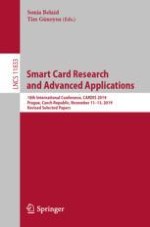
2020 | OriginalPaper | Buchkapitel
In-situ Extraction of Randomness from Computer Architecture Through Hardware Performance Counters
verfasst von : Manaar Alam, Astikey Singh, Sarani Bhattacharya, Kuheli Pratihar, Debdeep Mukhopadhyay
Erschienen in: Smart Card Research and Advanced Applications
Aktivieren Sie unsere intelligente Suche, um passende Fachinhalte oder Patente zu finden.
Wählen Sie Textabschnitte aus um mit Künstlicher Intelligenz passenden Patente zu finden. powered by
Markieren Sie Textabschnitte, um KI-gestützt weitere passende Inhalte zu finden. powered by